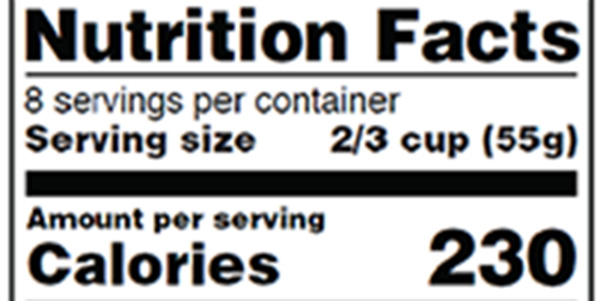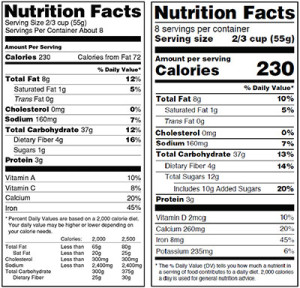It’s been over 25 years since the Nutrition Labeling and Education Act (NLEA) passed, requiring packaged foods to bear nutrition labeling and all health claims to be consistent with terms defined by the Secretary of Health and Human Services.
Like most legislative efforts, by the time NLEA became law, the provisions reflected concessions and left room for workarounds. Unfavorable calorie count? Reduce the serving size/increase the servings per package. High in sugar? Don’t list the daily value percentage. Void of nutritional value? Place a colorful “fat free” graphic on the packaging. The list goes on.
Efforts to improve nutritional labeling moved into high gear in 2014. On the path to finalization, the Food and Drug Administration (FDA) cycled proposed changes and accepted public comments for a period of several months. Last week, first lady Michelle Obama unveiled the new nutrition label at a health summit.
Here is a side-by-side look at the old and new labels:
Source: FDA
Yep, there’s been a dramatic change in the calorie count presentation. It jumps out of the box in a bold, headline-sized font. But the most significant change is actually what appears above it—the serving size. The new standard is based on current consumption habits, not on what a company or nutrition expert recommends.
This change is being met with applause and concern. On one hand, it puts an end to allowing manufacturers to arbitrarily increase the servings per package as a way of reducing the calorie count. Consumers are confronted with a realistic number. But on the other, it does nothing to address one of the biggest drivers of obesity and chronic disease: overeating. Some critics fear that consumers will view the adjusted serving size as a recommendation.
The new guidelines extend this standard to odd-sized packages too. For example, a 20-ounce bottle of soda will now be labeled as one serving, not two or three.
From our perspective, Americans are too obsessed with calorie count. Nutritional value is downplayed when it should be front and center. In his article for The Atlantic entitled “The Number to Avoid on the New Nutrition Labels,” James Hamblin explores the dangers of taking a calorie-centric approach to eating. He notes that, to avoid losing customers who are trying to limit calorie intake by changing their diets, manufacturers manipulate the calorie concept by producing 100 calorie packs of nutritionally-void “favorites.”
Along with the new calorie and serving size changes, guidelines surrounding sugar have also been met with praise and criticism. The upside is that manufacturers now have to list the percent daily value, which—with many sodas, candy and sugary snack foods—will exceed 100 percent.
Another major change with sugar is the addition of an “added sugars” disclosure. This enables consumers to see how much sugar they’re getting from nature and how much is being added during processing—both in grams and percent daily value measures.
Hamblin’s article addresses this change. As Mrs. Obama stated during the new format’s unveiling: “Most importantly, this label will tell you how much sugar in your snack was added during processing, and how much comes from ingredients like fruit.”
Hamblin was quick to mention that companies exploit this by adding things like apple juice and agave to everything kids eat so they can claim there is “no sugar added.” At the end of the day, too much sugar is too much sugar—regardless of whether it is squeezed from an orange or processed from sugarcane. Hamblin states that his ideal label would be one that enlarges and emphasizes the list of ingredients, noting that the best approach is to avoid food with labels altogether. (We couldn’t agree more!)
For a rundown on some of the other changes, check out Washington Posts’ article entitled “A first look at the FDA’s new nutrition label – and 10 reasons it’s different from the old one,” or visit the FDA website.


